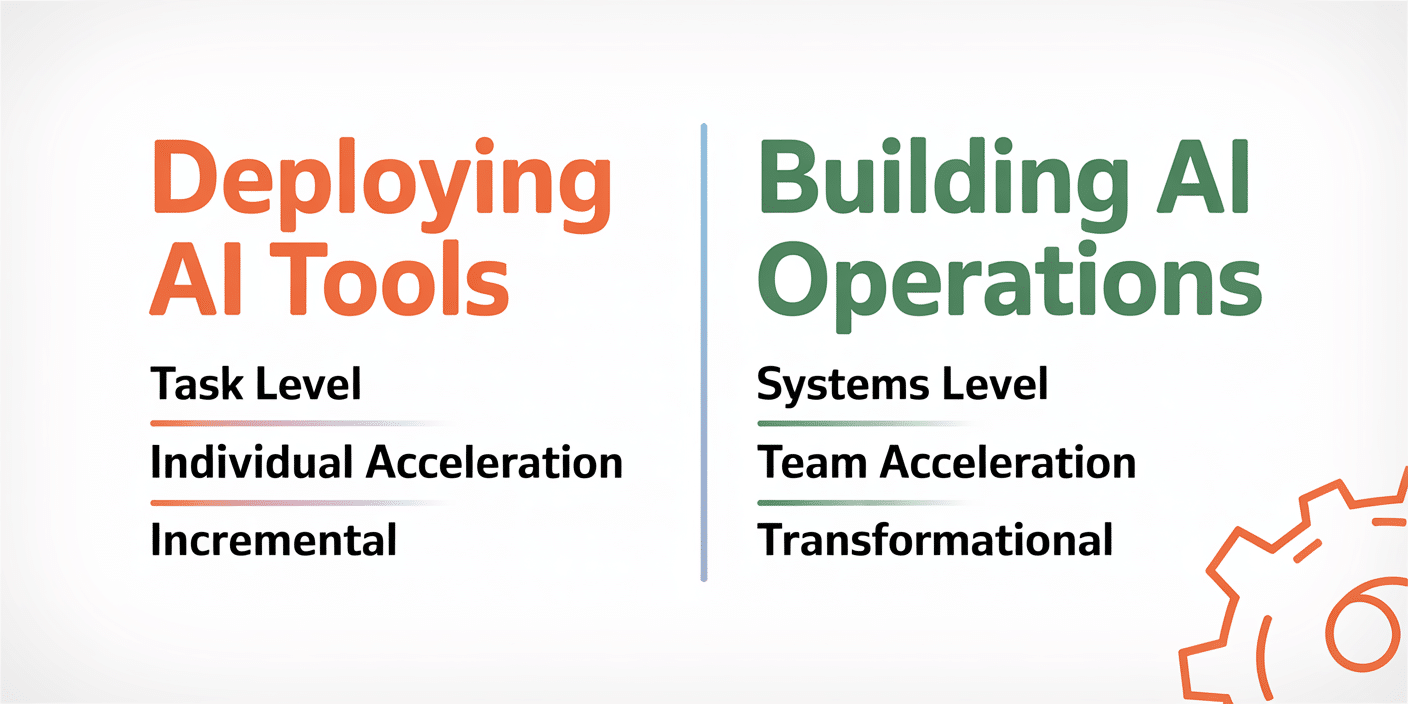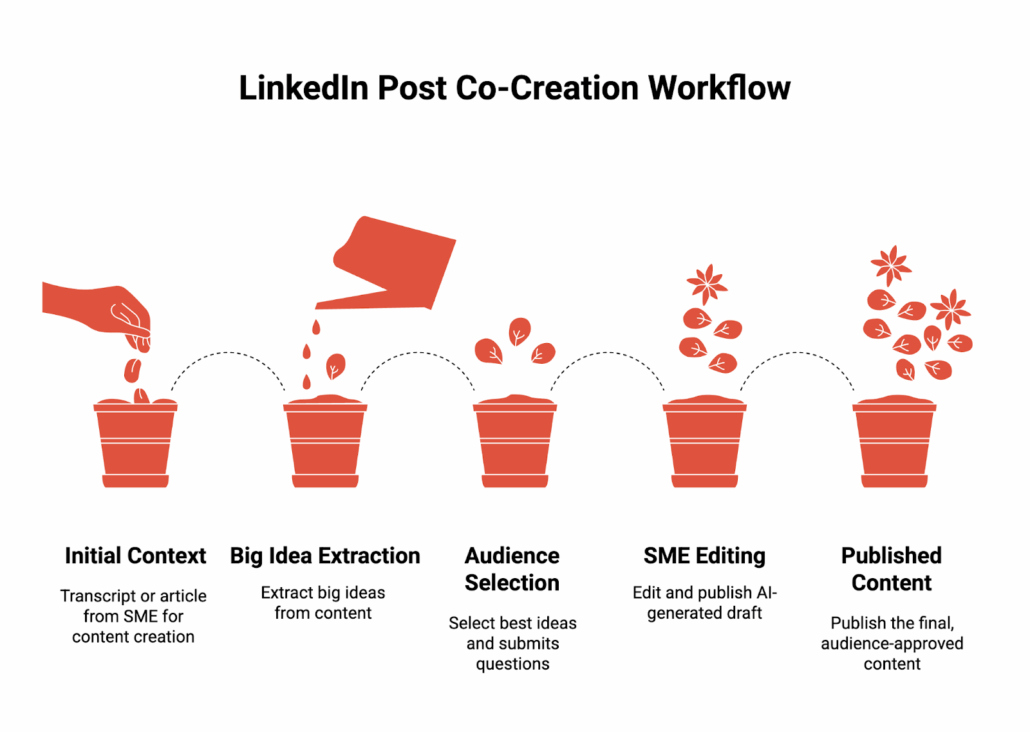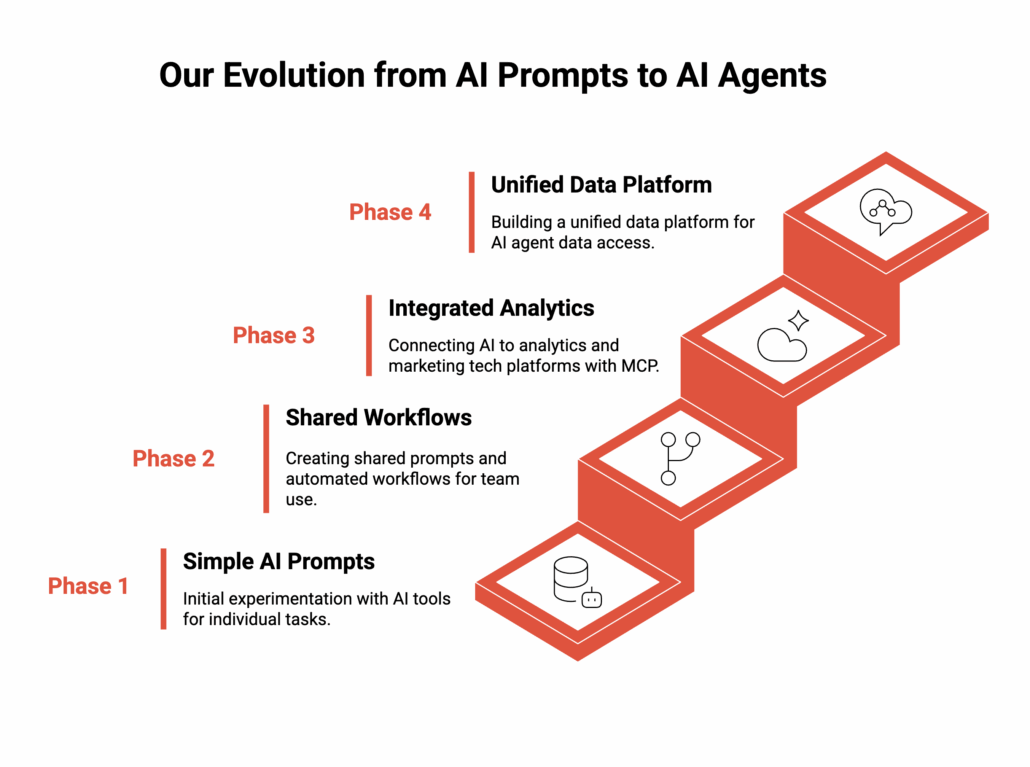
Beyond AI Tools
At Fire&Spark, we started with AI like most marketing teams: We gave everyone access to ChatGPT and said, “Use AI to automate tedious and annoying tasks.”
It worked… sorta.
Our team accelerated many individual tasks, but we quickly hit a ceiling after discovering prompts for most low-hanging fruit tasks. People were excited at first, cutting 15 minutes here, 20 minutes there. But after a year, the momentum stalled.
We were stuck in a pattern of scattered experimentation, with individual team members using ChatGPT with throw-away prompts that delivered isolated wins on specific tasks but nothing that fundamentally changed how we worked.
The real breakthrough came when we shifted away from “scratch your own itch” generative AI experimentation to building AI-powered marketing operations workflows. That’s when we stopped seeing marginal time savings and started measuring productivity improvements of 50% or more.
I’ve seen many marketing teams get stuck researching endless AI tool options. However, the most successful marketing teams are redesigning their work. They are building new AI-friendly workflows from the ground up, not struggling to automate the old way of working.
The real difference? They are building AI operations, not deploying AI tools.
The Critical Distinction That Changes Everything
Here’s what most teams miss: there’s a fundamental difference between deploying AI tools and building AI operations. It’s not semantic. It’s the difference between incremental AI improvements and AI transformation.
When deploying AI tools, you get scattered experimentation across the team, individual team members using ChatGPT with throw-away prompts, isolated wins on specific tasks, and marginal time savings on isolated tasks. One person figures out a clever prompt for writing sales emails. Another discovers how to generate video shorts faster.
These feel like wins, and they are, but they don’t scale. One CFO commented, “prompt-level wins can’t scale, but system-level workflows transform the whole function.”
Building AI operations looks completely different.
When building AI operations, your team is redesigning workflows to incorporate AI capabilities, creating shared prompts and automations that accelerate everyone’s work. Your team is connecting AI platforms to your data and marketing tech stack. Your team is measuring productivity improvements as roles are redefined around these new capabilities.
The distinction between deploying AI tools and building AI operations matters.
An AI prompt can generate output, but it lacks intent, context, and strategic direction. Too often we let the prompt, not the desired outcome, drive the output. That means AI outputs can be shallow, disjointed, or misaligned with marketing goals.
AI operations solves a bigger problem. You begin by choosing impactful marketing outcomes you want to accelerate. Then, you design the processes that produce the outcomes to be more AI-friendly. Next, you build the workflow to be executed by a team of humans and AI automations. Writing prompts is the final step, not the starting point.

What AI Operations Look Like in Practice
In our early experiments with prompting AI, we created AI prompts to help our internal SMEs develop ideas and write engaging LinkedIn posts.
The concept was simple: Give SMEs powerful tools to help use AI as a thought partner and express their thinking faster.
It worked in theory, but in practice, our thought leaders became the bottleneck. They didn’t need more tools. They needed a smarter workflow.
Here’s what happened:
Our First Attempt
- Our SMEs created AI prompts to extract ideas from transcripts and articles.
- They iterated on prompts to help them brainstorm and develop ideas.
- They created and improved prompts to generate drafts of LinkedIn posts.
We succeeded in generating ideas and drafts for LinkedIn posts with clever AI prompts. But, the content failed to engage our audience and our SMEs were still bottlenecks in the process.
We Needed to Change Our Approach
We realized that we needed a different approach. Rather than creating better prompts for our SMEs to automate heir existing workflow, we needed a new AI-friendly workflow.
We started by clarifying the outcome we wanted to produce: LinkedIn posts that engage our target audience.
Getting clear on the outcome is the most important step. The outcome we needed was not better prompts. We needed engaging LinkedIn posts.
Learning: Use AI to accelerate the outcome, not the tasks.
A better workflow began to emerge.
To surface more engaging content ideas, we needed to extract ideas from existing transcripts or articles then collaborate with our audience to identify and develop the most engaging ideas and publish them quickly.
Then we could use AI to draft the first draft of LinkedIn posts, using our brand voice, writing style, and other important context.
So accelerating this outcome would require:
- Extracting ideas from readily available context, usually transcripts or articles.
- Collaborating with audience members to choose the most engaging topics.
- Generating drafts of posts based on style and brand guidelines with additional context.
Finally, we created a custom web application that helped SMEs and members of our audience to co-create content. We recruited members of our target audience who understood what resonated and what questions they wanted answered. We gathered helpful context for our new workflow, like previously published articles, advisory call transcripts and workshop presentations.
Our New Workflow
- Start with a transcript or an article that we can hand to AI to extract big ideas.
- A member of our target audience, not our SME, selects the best ideas and teaching points. Then, they suggest questions the content should answer.
- Our SME receives an AI-generated draft for editing and publishing direct posting.
The shift from “deploying prompts for tasks” to “building AI workflows to produce outcomes” unlocked scale. It was only possible by rethinking our process for generating the outcome we needed.

What we achieved:
- The SMEs role became editorial, not operational.
- The audience’s role became participatory, feeding ideas and shaping the content narratives.
- The AI’s role became connective, linking raw insights with audience filtering and additional context needed to generate public-facing content.
This reframing turned a personal workflow into a collaborative publishing system. A workflow that builds consistency, saves time, and keeps the message aligned with what the audience actually cares about.
The Four-Phase AI Evolution
Here’s how our team evolved from scattered experimentation to AI operations. Think of this as a crawl-walk-run framework that shows you where to focus at each stage.
Phase 1 is where everyone starts: simple AI prompts for individual tasks using tools like ChatGPT. This is the experimentation phase. Let people play, discover use cases, and get comfortable with prompting. You’ll see immediate small wins, but don’t get stuck here. Most marketing teams spend too long in Phase 1. It feels productive, but you’re leaving the biggest gains on the table.
Phase 2 is where you start building momentum. This is when you create shared prompts and automated workflows using tools like Zapier, Make.com or N8N. Rather than everyone reinventing the wheel with their own prompts, you’re codifying the best ones and making them accessible to the whole team. You’re starting to connect prompts into sequences. Output from one AI task becomes input for the next. This is where you begin to see real time savings through the elimination of repetitive setup work.
Phase 3 is the breakthrough phase: connecting AI to analytics platforms. This is when we started using Claude with MCP connectors and building custom apps with platforms like Repl.it. Suddenly your AI experiments aren’t isolated. AI can read from your CRM, pull from your analytics platforms, and access your call transcripts. The AI has context, which means better outputs and fewer hallucinations. You’re no longer copying and pasting between systems. The workflow is actually integrated.
Phase 4 is building a unified data platform to aggregate data from multiple sources. For us, that meant using BigQuery to warehouse data from GA4, Search Console, and SEMrush. This is the foundation that makes AI agents possible. Your AI agents can pull from a single source data warehouse that combines all your marketing data. You can ask questions across datasets, spot patterns that were invisible with data living in silos, and build automations that respond to real-time changes across your entire marketing ecosystem.

This roadmap is helpful for understanding the progression, but I’ll be honest: we didn’t have it when we got started.
We learned by doing, made mistakes, and figured out what worked through trial and error. The phases emerged in hindsight. You don’t need to execute them perfectly. You need to recognize which phase you’re in and push yourself to the next one.
Here’s one HUGE learning:
Some marketers are solving their own problems one prompt at a time. These marketers are soloists.
Some marketers are building AI-driven workflows that lift everyone’s productivity. These marketers are multipliers.
Learning: Multipliers are 2x more valuable to your marketing team than soloists (sometimes as much as 10x more valuable) because they catalyze team acceleration through AI operations. Your soloists are merely deploying AI tools to accelerate their individual tasks.
Ask the Right Question
Most marketing teams are asking the wrong question.
They ask: “What AI tools should we use?”
That question leads you straight to tool evaluation, endless demos, comparison spreadsheets, and decision paralysis. You end up in a cycle of researching options while your competitors are building.
The right question is: “Which impactful marketing outcomes could we accelerate with AI?”
Start with the outcome. What takes too long? What’s too expensive? What requires too much manual coordination? Where are your best people spending time on work that doesn’t use their expertise?
Start with outcomes, and you can reverse engineer the result, then design the process and workflow, and only then find the right tools and create the right prompts and automations.
This reframe changes everything. You’re not looking at outputs like word count or time saved. Be measuring AI’s impact on important marketing outcomes that drive real business growth.
If AI does 90% of the work but delivers poor results, you’ve failed.
The goal isn’t to use AI. The goal is to achieve better marketing outcomes faster.
The Hard Truth About Building AI Operations
Let me level with you: integrating data, process, and people is easier said than done.
Rebuilding workflows from the ground up is a whole other job on top of the work.
That’s why sharing frameworks matters. That’s why staying laser-focused on AI operations and diligently avoiding the AI tools trap matters.
The marketing teams winning with AI aren’t the ones with the most tools or the best prompts. They’re the ones who had the courage to stop tinkering and start rebuilding.
It requires discipline and design, not just experimentation. Build AI into the architecture of your operations, integrated with data, process, and people, and you get compounding ROI.
Will it be uncomfortable? Yes.
Will it require learning new skills and technologies? Absolutely.
Will some workflows break before they get better? Probably.
But the alternative is watching your AI productivity gains plateau at 15-20%.
Your Next Move
You have a choice to make.
You can keep deploying AI tools, adding another prompt to your personal collection, trying out the latest AI platform, hoping that the next tool will be the one that changes everything.
Or you can start building AI operations, redesigning one critical workflow, connecting it to your existing data, and measuring the impact.
Build AI operations. Don’t deploy AI tools.

